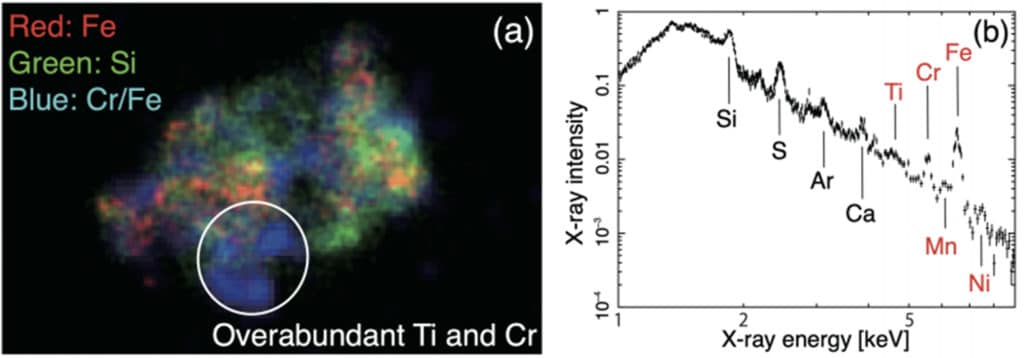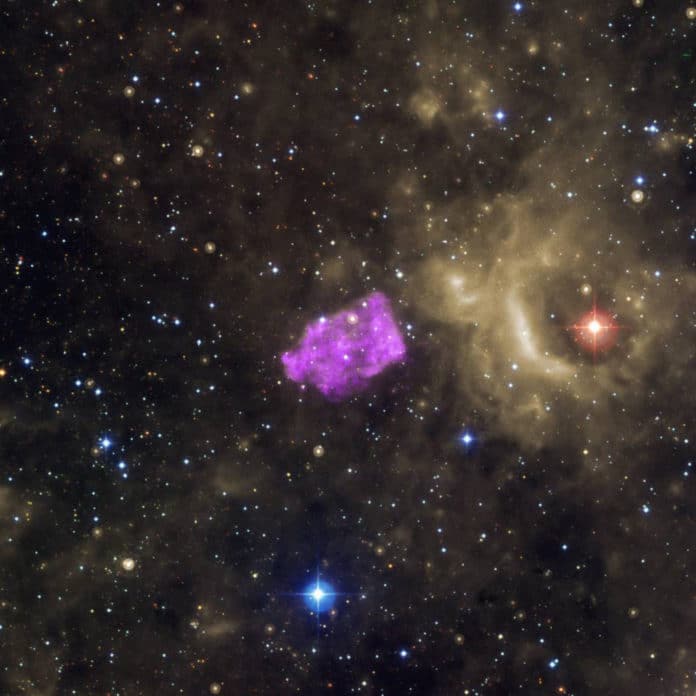An international collaboration recently measured the central density of white dwarf just before exploding as a so-called Type Ia supernova. Using data obtained from the astronomical satellite XMM-Newton, they made observations of the supernova remnant 3C 397 and measured its central density.
The supernovae remnant 3C 397 is a known Type Ia supernova remnant in the Milky Way. Previous data from Suzaku had suggested that the white dwarf progenitor of 3C 397, before the supernova explosion, must have a mass close to the Chandrasekhar mass limit (about 1.4 solar masses).
This motivated the team to perform follow-up observations of 3C 397 with XMM-Newton, utilizing the satellite’s enhanced angular resolution compared to Suzaku.
The key to the discovery is the first-ever detection of neutron-rich isotopes such as Titanium 50 and chromium 54 in the supernova remnant or debris. The higher the central density of the exploding white dwarf, the more efficient the production of these isotopes.

Scientists analyzed this relationship between the mass and isotopes. They then used it to determine that the central density of 3C 397’s progenitor was about three times higher than that of a typical Type Ia supernova progenitor.
This discovery adds to the mounting evidence for diversity in Type Ia supernovae, used in cosmology as distance indicators through the Universe.
For the study, scientists investigated the detailed spatial distribution of the heavy synthesized elements, specifically the local mass ratios of Ti, Cr, and other elements. They found a clumpy structure in the southern part of the remnant where the mass ratio of Ti and Cr compared to that of iron (Fe), and nickel (Ni) was abnormally high.
This is the first time that Ti has been detected from a Type Ia supernova or the remnant.
When they compared their results with models based on numerical calculations of supernovae nucleosynthesis, they found that the elemental mass ratios observed in 3C 397 could only be achieved in the innermost region of white dwarfs with a mass close to the Chandrasekhar limit that have exceptionally high central densities. The central density consistent with the observed elements is about 5 x 109 g cm-3, which is 2 – 3 times higher than the central densities(*5) that had been previously assumed.
In the future, scientists are looking forward to investigating the mass and central density of other white dwarfs before the supernova explosion. Doing so would allow them to characterize Type Ia supernovae so that they can be used as standard candles” to measure distances in the Universe.
The international collaboration behind this new result included Kavli Institute for the Physics and Mathematics of the Universe (Kavli IPMU) Senior Scientist Ken’ichi Nomoto and California Institute of Technology Postdoctoral Scholar Shing-Chi Leung (former Kavli IPMU Project Researcher) and was led by Yuken Ohshiro, a second-year masters student at the University of Tokyo’s Graduate School of Science, working with Professor Hiroya Yamaguchi (ISAS).
Journal Reference:
- Yuken Ohshiro et al. Discovery of a Highly Neutronized Ejecta Clump in the Type Ia Supernova Remnant 3C 397. DOI: 10.3847/2041-8213/abff5b
